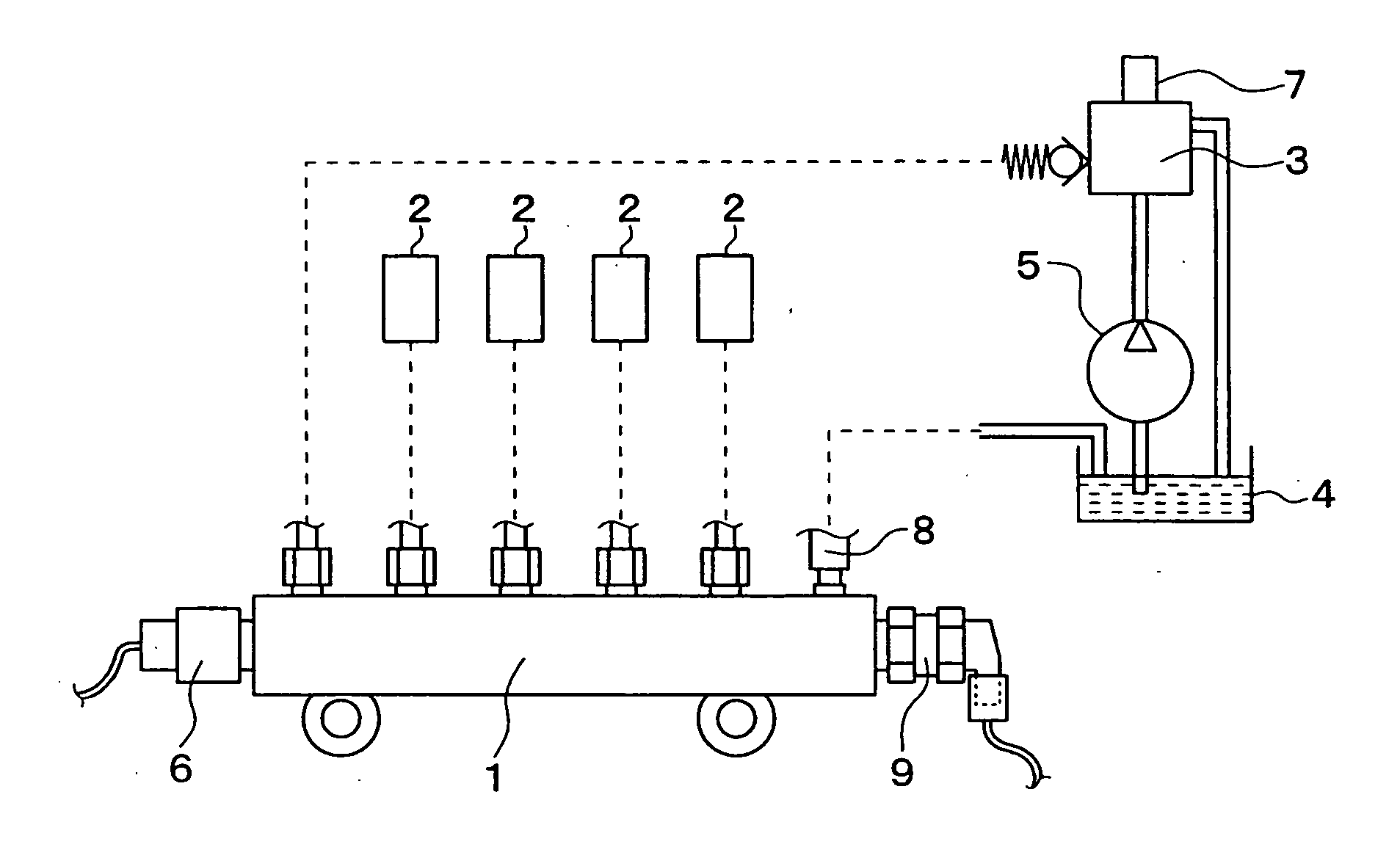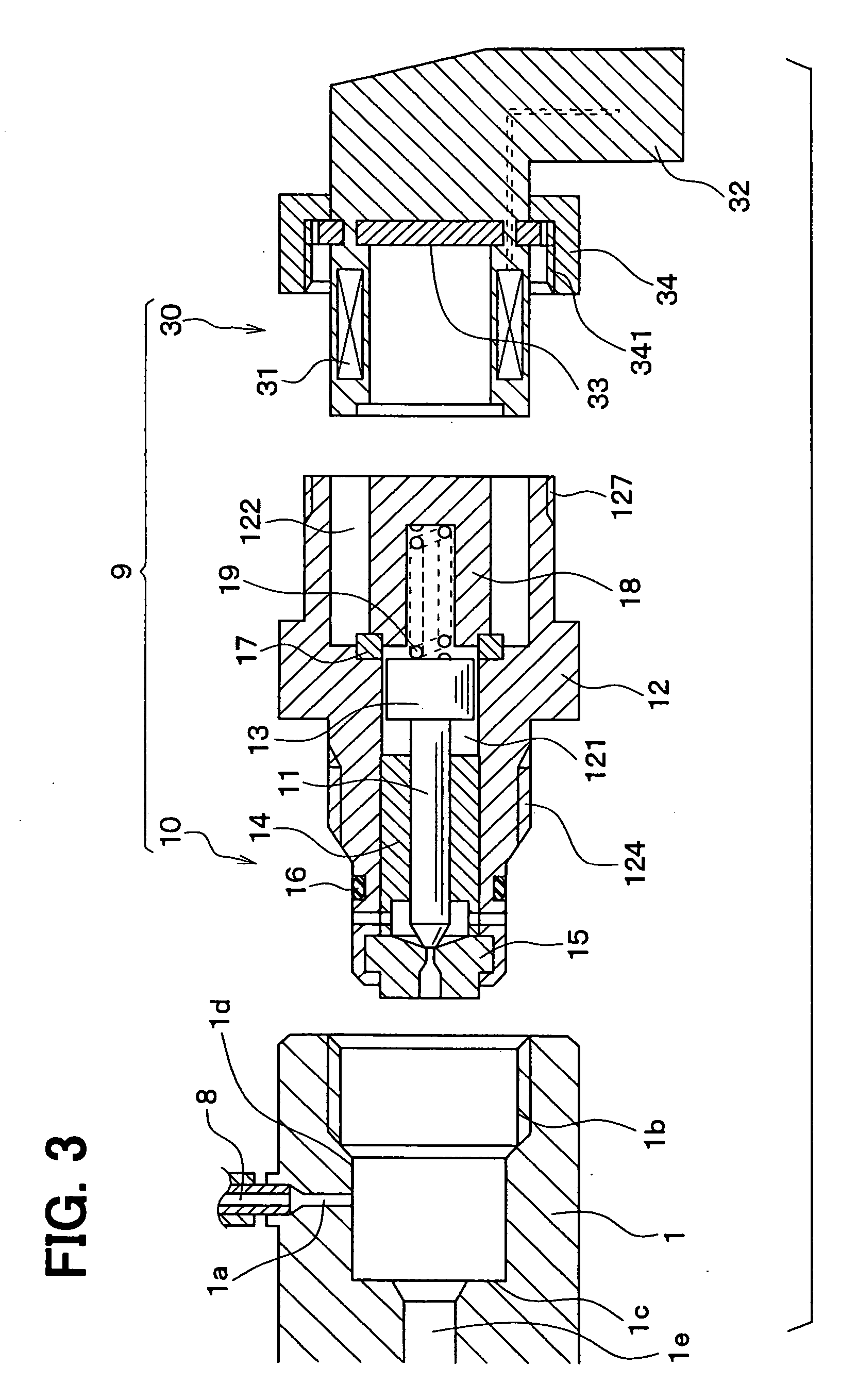Depressurizing valve and fuel injection device
a technology of depressurizing valve and fuel injection, which is applied in the direction of valve operating means/release devices, machines/engines, etc., can solve the problems of no space for the bolt hole, the air gap would be changed, and it is difficult to form the bolt hole in the common rail
- Summary
- Abstract
- Description
- Claims
- Application Information
AI Technical Summary
Benefits of technology
Problems solved by technology
Method used
Image
Examples
first embodiment
[0043] A first embodiment of the present invention will be disclosed. FIG. 1 is a schematic diagram showing a system structure of a common rail type fuel injection device having a depressurizing valve according to the first embodiment. The fuel injection device has a common rail 1, which is formed into almost a cylindrical shape and in which a high-pressure fuel is stored. Multiple fuel injection valves 2 are connected to the common rail 1, wherein the fuel injection valves 2 are mounted to respective engine cylinders of a diesel engine (not shown) so that the high pressure fuel stored in the common rail 1 is injected into the engine cylinders through the respective fuel injection valves 2. A valve opening timing as well as a valve opening period for the respective fuel injection valves 2 is controlled by an electronic control unit (ECU) which is not shown in the drawing.
[0044] The ECU comprises a well known microcomputer having CPU, ROM, RAM and so on, and carries out various kind...
second embodiment
[0072] A second embodiment of the present invention will be explained. FIG. 5 shows a cross sectional view of the depressurizing valve according to the second embodiment. The same reference numerals are given to the same or similar parts to the first embodiment.
[0073] In the above first embodiment, the coil unit 30 is assembled to the valve unit 10 by the retaining nut 34, wherein the female screw portion 341 of the retaining nut 34 is screwed with the male screw portion 127 of the valve housing 12. The second embodiment differs from the first embodiment in the assembling method of the coil unit 30 to the valve unit 10.
[0074] As shown in FIG. 5, a bolt 35 is used as a fixing means. More exactly, a female screw portion 182 is formed at the stator core 18, a through hole 322 is formed in the connector 32 for inserting the bolt 35, and a through hole 331 is formed in the plate 33 for also inserting a screwed portion of the bolt 35. The bolt 35 can be formed as a hexagon head bolt, a ...
third embodiment
[0076] A third embodiment of the present invention will be explained. FIG. 6 shows a cross sectional view of the depressurizing valve according to the third embodiment. The same reference numerals are given to the same or similar parts to the first embodiment.
[0077] In the first embodiment, the ring-shaped connecting member 17 is used for connecting the valve body 11 to the stator core 18. According to the third embodiment, a pipe-shaped connecting member 17a having a thin wall is used.
[0078] If the connecting member 17 was made of the magnetic material in the first embodiment, the magnetic flux may not flow from the stator core 18 to the armature 13, but flows from the stator core 18 to the valve housing 12 through the connecting member 17. Then, the attracting force is not generated at the armature 13. This is because the connecting member 17 must be made of the non-magnetic material in the first embodiment.
[0079] On the other hand, the connecting member 17a of the third embodi...
PUM
 Login to View More
Login to View More Abstract
Description
Claims
Application Information
 Login to View More
Login to View More - R&D
- Intellectual Property
- Life Sciences
- Materials
- Tech Scout
- Unparalleled Data Quality
- Higher Quality Content
- 60% Fewer Hallucinations
Browse by: Latest US Patents, China's latest patents, Technical Efficacy Thesaurus, Application Domain, Technology Topic, Popular Technical Reports.
© 2025 PatSnap. All rights reserved.Legal|Privacy policy|Modern Slavery Act Transparency Statement|Sitemap|About US| Contact US: help@patsnap.com



